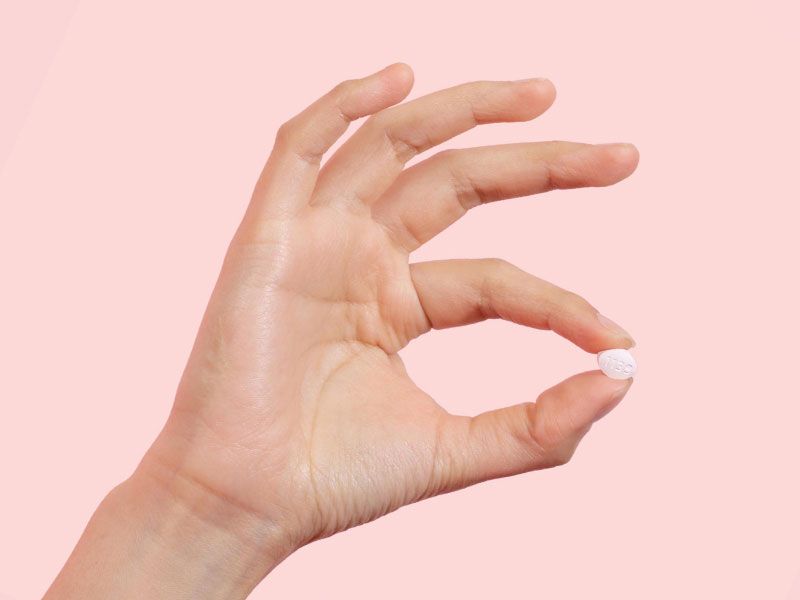
BV vs Yeast Infections:
How to Tell The Difference?
Published on August 8, 2023
Updated on March 10, 2025
Written by Kathleen Morrison
Medically Reviewed by Andrea Sleeth WHNP-BC, MSCP
Noticing itching, odd discharge, or a fishy smell and wondering what’s up? You’re not alone—vaginal health questions are super common, and you deserve clear, no-BS answers.
While BV (bacterial vaginosis) and yeast infections share some similar symptoms, they’re actually completely different issues that need different treatments.
Knowing what’s happening with your body helps you find relief faster—without wasting time (or money) on the wrong treatments. Let’s break it down so you can get back to feeling like yourself ASAP.
What's the Difference?
BV and yeast infections are both vaginal infections, and they can feel pretty similar.
Both can cause discharge, irritation, and general discomfort—but they come from totally different sources. BV happens when the natural bacteria in your vagina get thrown off balance, while yeast infections are caused by an overgrowth of fungus (Candida). Sounds kind of gross, but it’s normal.
Your vagina is a self-cleaning powerhouse designed to keep everything in balance. But sometimes, certain factors—things like douching, using scented soaps, tight clothing, or even hormonal changes—can tip the scales, allowing bacteria or yeast to overgrow. That’s typically when either BV or a yeast infection might show up.
How to Tell Them Apart
A key difference? Discharge and odor.
- BV often comes with a thin, grayish discharge and a fishy smell—especially after sex.
- Yeast infections usually cause a thick, white, cottage cheese-like discharge with intense itching and irritation (but no strong odor).
Neither is a sign of poor hygiene, and both are extremely common—so if you’re dealing with one (or both), there’s no need to be embarrassed.
Why They’re Important to Treat
It’s tempting to wait it out and hope things clear up on their own, but that’s not always the best move.
Untreated BV can increase the risk of complications, and a yeast infection left unchecked can make everyday life miserable. The good news is that both are easy to treat once you know what you’re dealing with.
What Are the Symptoms?
BV and yeast infections can feel annoyingly similar, so it’s no surprise they get mixed up. A little discharge here, a bit of itch there—how are you supposed to know what’s what? But your body gives you clues. Knowing all the key symptoms can help you figure out what’s going on so you can treat it fast and feel better ASAP.
BV Symptoms
BV usually comes with:
- Thin, gray or pale yellow discharge
- A strong, fishy odor (especially after sex)
- Mild irritation or a slight burning sensation when peeing
- Little to no itching
Sometimes, BV symptoms come and go, but if they stick around, it’s best to treat them. Left untreated, BV can increase the risk of other infections. And while drinking water and wearing breathable underwear might help a little, BV usually needs medical treatment to clear up fully.
If your symptoms don't clear up after antibiotic treatment, you should talk to your provider about more testing. Mycoplasma and Ureaplasma can also cause symptoms that look like BV but require a different treatment. You'll always want an STI and STD consult to make sure you're clear of any STIs.
Yeast Infection Symptoms
Yeast infections, on the other hand, tend to come with:
- Thick, white, clumpy discharge (often compared to cottage cheese)
- Intense vaginal itching (like, can’t-ignore-it level)
- Redness, swelling, or even tiny cracks in the skin
- Burning when peeing or discomfort during sex
Yeast infections thrive in warm, moist environments—so tight pants, sweaty workouts, and damp bathing suits can all make things worse. Over-the-counter antifungal medications can usually help, but using the wrong treatment can make symptoms worse—so it’s always smart to double-check what’s going on.
The Smell Test
One quick way to tell the difference is odor.
- BV often has a noticeable fishy smell.
- Yeast infections? Not so much.
If you’re still unsure, talking to a healthcare provider is the fastest way to get relief.
What Causes Them?
Spoiler alert: it’s not poor hygiene. Your vagina is a self-cleaning pro, but certain factors can throw off its balance. BV and yeast infections happen for different reasons, but they share some common triggers.
What Causes Bacterial Vaginosis?
BV happens when the healthy bacteria in your vagina (Lactobacilli) get outnumbered by other bacteria. This can happen due to:
- Douching or using scented soaps (they mess with your vaginal pH)
- New or multiple sexual partners (semen can alter vaginal balance)
- Hormonal shifts (like your period or pregnancy)
- Smoking (yep, it can impact vaginal bacteria)
Sometimes, BV doesn’t cause symptoms, but it can increase the risk of other infections—so if something feels off, it’s worth checking out.
What Causes Yeast Infections?
Yeast infections happen when Candida (a type of fungus that’s normally present in small amounts) overgrows. This can be triggered by:
- Antibiotics (they wipe out good bacteria that keep yeast in check)
- High blood sugar (yeast loves sugar, so diabetes can be a factor)
- Hormonal changes (pregnancy, birth control, and periods can play a role)
- Tight, damp clothing (sweaty leggings + long days = yeast paradise)
If you get chronic yeast infections, consider small lifestyle shifts—like changing out of gym clothes ASAP or opting for breathable cotton underwear. And if they keep coming back, a healthcare provider can help you find the right long-term solution.
Getting it Diagnosed
When something feels off down there, getting the right diagnosis is key. No one wants to waste time treating a yeast infection if the real culprit is BV—or vice versa. While some symptoms overlap, these infections need different treatments, so figuring out what’s really going on can save you from discomfort, frustration, and repeat flare-ups.
How BV is Diagnosed
A healthcare provider can usually diagnose BV with a quick chat about your symptoms, a physical exam, and a simple vaginal swab. Under a microscope, BV shows up as an overgrowth of certain bacteria. A pH test can also help—if your vaginal pH is 4.5 or higher, it’s a strong sign of BV. Some tests even check for that telltale fishy odor when mixed with a special solution, like a smelly science experiment.
Catching BV early isn’t just about feeling better ASAP—it can also help reduce the risk of complications like recurrent bacterial vaginosis, STIs, or fertility concerns. The sooner you get the right diagnosis, the sooner you can get back to feeling good.
How Yeast Infections Are Diagnosed
Testing for a vaginal yeast infection looks similar, but instead of bacteria, providers check for an overgrowth of Candida fungus. A quick swab of vaginal discharge can confirm if yeast is the issue. If infections keep coming back, a lab culture might be needed to identify the exact species of yeast—that’s especially helpful if standard treatments haven’t been working.
In many cases, providers can spot a yeast infection just by looking. If you’re dealing with thick, clumpy discharge and relentless itching, the signs are pretty clear. But if you’re unsure or stuck in a cycle of recurring infections, getting tested can save you from endless trial-and-error treatments.
Getting it Treated
Getting the right treatment makes all the difference. BV and yeast infections are caused by completely different things, so a one-size-fits-all approach won’t cut it. Choosing the right meds means faster relief and a lower chance of your symptoms making a comeback.
Best Treatments for BV
The first line of defense when it comes to treating BV is usually antibiotics like metronidazole (oral or gel) or clindamycin cream. These target the bacteria overgrowth and help restore balance. One important tip is to finish the full prescription, even if you feel better halfway through. Stopping early can let the bacteria grow back, setting you up for another round of discomfort.
Probiotics might help, too! While research is mixed, some people find that adding probiotic supplements or eating probiotic-rich foods (like yogurt or kefir) helps keep their vaginal flora in check. And if you’re prone to BV, avoiding douching and harsh soaps can help avoid future flare-ups.
Since BV can increase the risk of infections and other complications, treating it ASAP is the best move for your overall health.
Best Treatments for Yeast Infections
Healthcare practitioners will usually suggest treating yeast infections with antifungal creams, suppositories, or oral medications. Some people prefer a single-dose pill, while others go for multi-day treatments—it depends on how severe or frequent your infections are. Either way, relief usually kicks in fast once the fungus is under control.
To keep yeast in check, small lifestyle tweaks can make a big impact, too. Loose-fitting clothes (especially in hot weather) and avoiding damp or sweaty fabrics for long periods can also help you steer clear of future infections. If you tend to get yeast infections after taking antibiotics, let your provider know—they may suggest a preventive antifungal.
As with BV, completing the full course of treatment is key. Stopping too soon can leave behind just enough yeast for it to come back stronger. If your infections keep recurring, a healthcare provider can help figure out why and find a better long-term solution.
How to Avoid Getting BV or a Yeast Infection
Avoiding infections doesn’t require obsessing over every little thing in your routine—it’s just about making small, smart choices that support your body’s natural balance. Daily habits, from hygiene to what you wear, can make a big difference in keeping infections at bay.
Lifestyle Tips for a Healthy Vagina
- Probiotics for the win: Some evidence suggests that probiotics (from food or supplements) might help maintain a healthy vaginal microbiome.
- Less sugar, less yeast: Since yeast feeds on sugar, cutting back on processed sweets may help you avoid overgrowth.
- Stay dry: If you tend to get infections after workouts or swims, swap out damp clothes ASAP to reduce moisture buildup.
- Practice safe sex: Using protection can help prevent pH imbalances and lower your risk of infections.
- Manage stress: Chronic stress can weaken your immune system, making it easier for infections to take hold. Taking care of your overall health helps your body naturally fight off unwanted bacteria and yeast.
Hygiene Habits That Help
- Ditch the douches: Your vagina is self-cleaning—douching can actually increase your risk of infections by disrupting its natural balance.
- Go fragrance-free: Scented soaps, wipes, or sprays can be irritating. Stick to mild, unscented options when washing the area.
- Change hygiene products often: Tampons, pads, liners, and period cups should be swapped regularly to keep bacteria from building up.
- Store products properly: Keeping tampons or pads in damp spaces (like your bathroom) can expose them to mold or bacteria—store them somewhere dry instead.
Keep Infections At Bay
BV and yeast infections are both really common, but that doesn’t make them any less frustrating.
If your symptoms aren’t clearing up—or they keep coming back—chatting with a healthcare provider can make all the difference. No one should have to put up with discomfort or uncertainty.
Why suffer through itching, irritation, or embarrassing odors when relief is just a few clicks away? With Wisp, you can get doctor-approved treatment for BV and yeast infections online—no appointments, no waiting rooms, and no judgment. Get same-day prescription pickup or free delivery straight to your door. Take charge of your vaginal health today.
Wisp treatment options are available only after consultation with a licensed medical professional. You should consult with your healthcare provider before starting a new supplement or treatment regimen. Individual results may vary.
Frequently Asked Questions (FAQ):
How do I tell if I have a yeast infection or BV?
Yeast infections usually come with thick, white, clumpy discharge (think cottage cheese) and intense itching. BV, on the other hand, causes thin, gray or yellow discharge with a strong fishy odor. If you’re still unsure, testing can help confirm what’s going on so you can start the right treatment.
How long does BV last if untreated?
BV can stick around for weeks or even months if left untreated. It can also increase the risk of other infections, including STIs. The good news? It’s easy to treat with the right medication, so you don’t have to suffer through it.
What are symptoms of BV in females?
BV symptoms often include thin, gray or yellow discharge with a noticeable fishy smell. Some people also experience mild irritation, but others don’t feel any discomfort at all. If you notice a persistent odor or unusual discharge, getting treatment can help restore balance and avoid further complications.

BV Antibiotics (Tablets or Gel)
Starting at $15
Request topical or oral prescription antibiotics to treat bacterial vaginosis.

Diflucan, Generic Fluconazole (Yeast Antifungals)
Starting at $45
Prescription antifungals used to treat vaginal yeast infections

